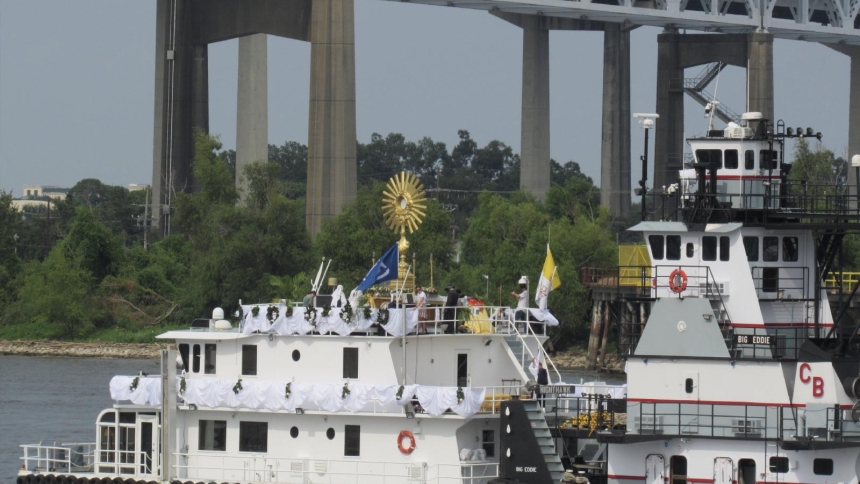
(OSV News) -- "There is a river whose streams make glad the city of God, the holy habitation of the Most High" (Ps 46:5).
The psalmist was clearly not speaking about the Mississippi. But his words would have been an apt description of the joy so many experienced on the banks of America's great river Aug. 14-15 as boats ferried the holy Eucharist in Louisiana from Baton Rouge to New Orleans — a distance of 130 miles.
Organized by the Community of Jesus Crucified in St. Martinville, Louisiana, the Fête-Dieu (French for "Godfest"), was two years in the making. The event was as ambitious as it was bold. Unlike most traditional expressions of Catholic faith, the Fête-Dieu required a team of engineers. Ladders and a boom lift were used throughout the procession to manage the 14-foot monstrance, and several tools were created to lift, tilt or move it from boat to church and back.
That didn't keep the procession from being conducted with deep reverence. Designated boats rang bells, burned incense, and displayed a larger-than-life-sized crucifix and statues of the Virgin Mary and St. Joseph. A treasury of traditional hymns and prayers united believers of all ages and backgrounds in worship. Everything was executed with transcendent beauty and grandeur.
The large-scale undertaking was intended to stir up a current of new evangelization and Eucharistic revival across the state of Louisiana, and to bring the blessing of God to the river itself. As Fête-Dieu organizer Father Michael Champagne explained, "The Mississippi has never been blessed. I talked with a man who has worked on the river for 50 years. He said, 'I'm a Baptist, but we need to bless this river!'"
And bless it they did, with the sacramental presence of Jesus in the Eucharist. The flotilla of barges brought thousands of Louisiana Catholics to their knees, as the spectacular monstrance, canopy, altar and host — all specially made for this event — passed by. The two-day procession stopped at towns along the route for "River Rallies" where residents and pilgrims alike could express their faith by walking in processions, or by participating in prayer services, adoration and Benediction.
The event began Aug. 14 with Mass at the Cathedral of St. Joseph in the state's capital of Baton Rouge. Bishop Michael G. Duca encouraged the standing-room only congregation, "Jesus Christ is Lord, and he is with us! Today, we bring Christ out of the church and into the world. Our pilgrimage begins when we open our hearts to Jesus."
The 14-inch host — large enough to be seen from the levees — was consecrated, then placed in the monstrance and processed more than a mile to the boats. Despite extreme heat and humidity, the joy was tangible.
Bishop Glen J. Provost of Lake Charles addressed those gathered in Donaldsonville, a town 55 miles downriver from Baton Rouge. Priests assigned to two decommissioned ambulances known as "Spiritual Care Units" offered sacramental confession.
A similarly adapted fire truck, equipped with a pulpit, provided a platform for nationally recognized speakers, such as Father Josh Johnson, author and vocations director of the Diocese of Baton Rouge, and Tom Neal, an author, former seminary dean and currently director of evangelization and mission engagement for the Diocese of Pensacola, Florida. It was an effective way to address large riverside crowds.
The flotilla completed 70 miles, arriving in Convent, Louisiana, shortly before sunset. The large monstrance was processed down the levee to St. Michael the Archangel Church, where a crowd of approximately 1,500 — three times the town's population — had gathered. Wide-eyed congregants gasped when the 220-pound monstrance was tilted and borne horizontally down the center aisle, then placed upright in the sanctuary under a stunning image of the Lamb of God.
A flaming beacon was lit on the levee above St. Michael's and solemn vespers was offered. Louisiana native Dominican Father Aquinas Guilbeau offered the reflection.
"The Mississippi River has no greater herald than Mark Twain," Father Guilbeau said. "For Twain, being on the river was like being in church. But we have made the river a kind of church. Wherever there is an altar, a tabernacle, a monstrance, God is there. Christ is with us," he observed. "He makes the journey joyful." Compline, or night prayer, closed out the evening before all-night Eucharistic adoration commenced.
On Aug. 15, the solemnity of the Assumption began with matins and lauds. Large groups of Catholic school students attended "River Rallies" in Reserve and Luling before the procession reached the final rally at Audubon Park in New Orleans.
In anticipation of its arrival, 1,000 adorers embarked on America's last operating Mississippi steamboat, the proclaimed-to-be 99-year-old Natchez. They met the flotilla on the water and were led in a Holy Hour. Passengers included priests, deacons and religious, seminarians, families with young children, high school students and young adults as well as the elderly. Before departing from the pier, familiar hymns were played on the boat's historic calliope.
Docked at the edge of the city's famous French Quarter, the Most Blessed Sacrament was brought to St. Louis Cathedral for vespers, Benediction and Mass of the Assumption celebrated by Archbishop Gregory M. Aymond. Because the basilica was filled beyond capacity, the Mass was broadcast through outdoor speakers and priests brought holy Communion to people who were unable to get inside. The evening concluded with a live Cajun music band just outside the cathedral in Jackson Square.
Catholics across the United States have been asking whether efforts like the National Eucharistic Revival can succeed in taking root. If grand and creative initiatives like the Fete-Dieu du Mississippi are any indication, the answer is a resounding — and joyful — yes.


